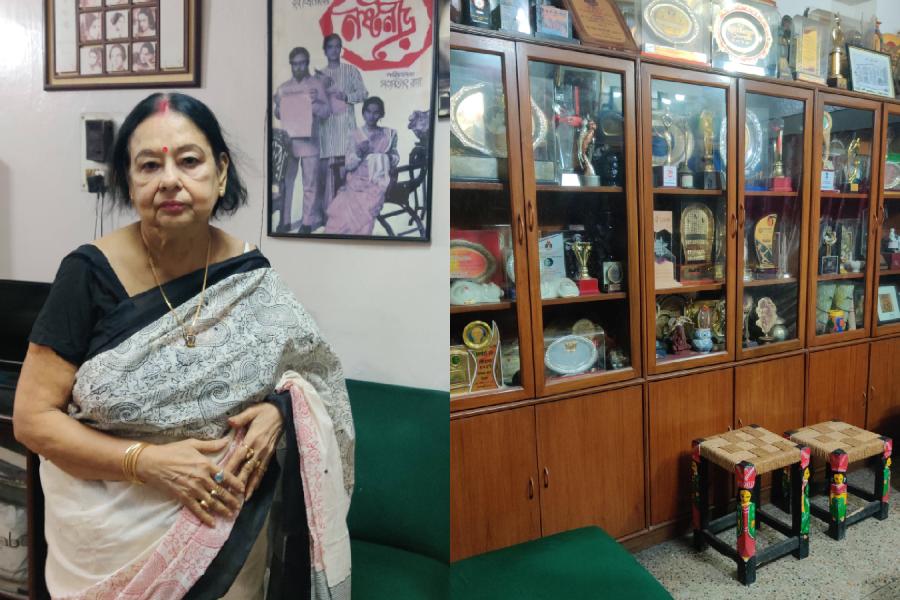In the first days of research for my biography of Soumitra Chatterjee, I stepped into his world through his writings. His memoirs, musings and urgent essays, written in beautiful Bengali prose, compiled and edited in two big volumes by Samik Bandyopadhyay and Ranjan Mitra. His poetry, in which he bared his soul, was often my window to the man. Later, I had access to his letters and journals, which allowed me a deeper, more unambiguous gaze. And then there were theatre scripts such as Tritiya Onko Otoeb, based on his own life experiences, particularly the dramatic episodes.
I read in fascination his long interview with filmmaker Anasua Roy Choudhury, for the Oral History Project of Pune’s National Film Archives done almost 25 years ago. It was like being in the room with them. Of course, it was a joy watching Soumitra’s films, one after the other, to observe him at work. From the sublime Apur Sansar (1959) to the ridiculous Pratisodh (1981). It was a delight listening to his interviews, especially the ones with ABP Ananda.
For Soumitra Chatterjee and His World, I searched for him through the eyes of those who knew him well – his family and friends but also those who worked closely with him. I came back with special memories, always; here are three I picked for you.
Madhabi Mukherjee
My first memorable encounter was with Madhabi Mukherjee, Charu to Soumitra’s Amal in Charulata (1961). Madhabi first met Soumitra Chatterjee at the narration of Mrinal Sen’s film Punashcha (1961), in the director’s home. But ultimately, she was not in the film. Yet that first meeting was the beginning of a lifelong association and journey of mutual admiration. “My daughters will not hear a word of anything adverse about him,” Madhabi said with a slight frown.
Her eldest, Mimi Bhattacharya, takes me along to her home. The actor lives alone in a middle-class housing society in south Kolkata. As we walk up to her flat, I notice the patchy walls in the stairway and the blurry neon lights. Mimi’s mother has been watching a Bengali serial, on STAR Jalsha, but hearing her voice she switches off the TV and steps forward.
Madhabi Mukherjee is standing in front of me – I notice her black hair and crisp Tangail cotton. That evening she has used light make-up, as if as a reminder of her past life. I feel a tinge of guilt as I have not brought a photographer along. I look around the room and find there are old photographs on every wall, the most visible of which is a rare poster of Charulata when the film was still called Nashtanir. Satyajit Ray had to change the name as there was another Bengali film by that name. He named it after the beauteous lonely wife at the heart of his magnificent film.
I cannot help but share with the legendary Madhabi what Amal and Charu have meant for generations of Bengali cinephiles. Who can forget their banter, that scene where Amal is sprawled on the grass in Charu’s garden reading, and she is on the swing looking like a dream, their mock fights and flying repartee. How could this intense chemistry not touch the actors, I ask her.
“Well, I am not a romantic person,” Madhabi says, unmoved.
“Did you see yourself in the Charulata years? It would be hard not to fall in love with you!” She ignores my compliment, and we move on to topics beyond this.
At some stage we arrive at Uttam Kumar, and Madhabi, I find, is clearly still a big fan, especially of his large-heartedness. “Can you tell me a little about the relationship between Uttam and Soumitra?” I ask. She leans forward and says, “Bolbo na (I am not telling you)!”
As we chat, Madhabi drops her defence gradually. And by the time it is time for me to leave, we are almost friends. I gaze admiringly at the dozens of awards she has received over the years and photographs that capture those moments, all kept in a room, where she meets the media.
When it’s time to leave, she absolutely insists that I call my Uber driver into her society gate. “It’s late, why will you walk needlessly?” she says and proceeds to ask the guard to call the vehicle in. As I leave, I look up. Madhabi is looking down from her first-floor balcony, waving at me. “Abar esho,” she had told me at her door.
As my Uber drives away, I look back. Madhabi Mukherjee is waving at me still, and I wave back at her. My chest tightens, as the cab speeds away, and then our Charulata disappears out of my sight.
Sandip Ray
Standing in front of Satyajit Ray’s flat on Bishop Lefroy Road, I imagine the big man opening the door for me, as he did so often in his prime. He would have to bend down quite low to speak with me, given my height. A domestic help at the Ray home gets the door instead and ushers me in. I walk in through the famous corridor where the auteur took walks in his later years. I notice a life-size photograph of his father Sukumar Ray on the right. As I enter the room where Sandip Ray will meet me, their spaniel Lucci – a fond shorthand for Bertolucci – greets me, and the very pleasant Lolita Ray also drops in to say hello.
Sandip Ray is warm and engages with me with interest. He has watched his Soumitra Kaku since he was a boy, and he seemed to enjoy talking about him. He reveals his early memories among which I find a gem. The first time that his famous father took little Sandip to a film shoot, he was probably five. The set was packed with people and the camera had started rolling. Suddenly little Sandip’s shrill voice pierced through the silence. “Cut!” he screamed and ran away, leaving everyone in splits. Having set this tone, he talks about his delight of observing Soumitra Chatterjee at work.
I returned once more to the Ray house. And on this occasion, I stepped into the room where Satyajit Ray created his magical oeuvre and opened the door for his visitors, startling some of them. The room is now modern, with a desktop computer, printers and other gadgets. But alongside, it is stacked with extremely valuable memorabilia – the first copy of Bibhutibhushan Bandyopadhyay’s Pather Panchali that Ray used to write his script is among them. There are replicas of some big awards lining the shelves. The Jamini Roy painting that we remember from Feluda’s drawing room – in fact, painted by Satyajit Ray – rests against a wall in this remarkable room.
Ray’s chair, almost as iconic as the man, covered in brown leather, is prominent among many other belongings. There is a modern glass and metallic shelf where Ray’s scripts are kept – looking through the titles I feel mild goosebumps. There are several boxes containing letters from top Hollywood personalities of that era. This is a room that is rarely opened to outsiders, but thanks to a friend, who knows Sandip Ray well, I could silently worship at Satyajit Ray’s altar.
Nripen Ganguly
Nripen Ganguly was the last living directorial assistant of Ray’s. He was also a close associate of Soumitra – the Chatterjees considered him a dependable friend always. Universally known as Nyapada, he chose to remain single all his life and was always available to Soumitra and his family. When the actor and his wife travelled, Nyapada would often take care of their children.
I visited the 93-year-old twice in the space of a few weeks and was regaled by amazing stories of the old days. Nyapada was a regular at Paradise Cafe on Rashbehari Avenue, in south Kolkata, where Mrinal Sen, Ritwik Ghatak, Salil Chowdhury and other stalwarts had a circle of adda growing around them. Nyapada not only learnt filmmaking watching Ray closely, he also made the award-winning children’s film Bhombal Sardar (1983). My book has one important episode from Soumitra Chatterjee’s 1985 appearance at the Festival of India in Paris, which Nyapada had narrated to me.
Just a month after I met him, we got the tragic news. The gentle, genial Nyapada had passed away, leaving a chest full of memories with me.











